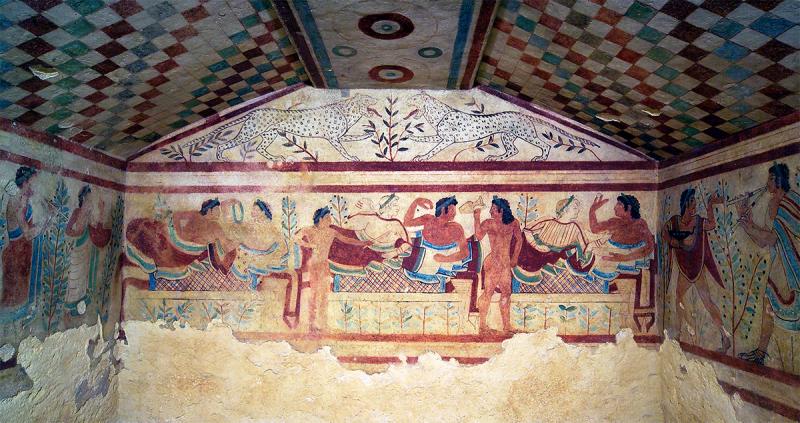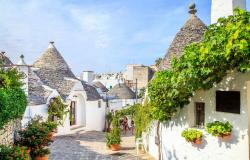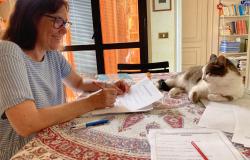Tarquinia: Near Rome, a Trip into Etruscan Art and Religion
ITA:

[Photo: Tomb of the Leopards in the Monterozzi Necropolis. Photo credit: http://civitavecchia.portmobility.it.]
Tarquinia was once one of the most important Etruscan cities, a cradle of Etruscan culture and religion, located about an hour from Rome. It is now listed as a Unesco World Heritage site for the number of painted tombs in the so-called necropolis of Monterozzi, which an Italian archeology has described as “the first chapter in the history of Italian painting art.”
There are more than 200 painted tombs, with scenes depicting animals, musicians, dancers, soldiers, and banquets. Historians believe these decorations were reserved for the wealthiest citizens.
Some of the most outstanding examples include the tombs of the Leopards, of the Lioness, of the Warrior, of Hunting and Fishing, of the Hunter, and of the Cardarelli.
The presence of the largest known Etruscan temple, Ara della Regina, attests to the fact that Tarquinia was a major religious center in Etruscan times. Dating to at least the 7th century, it was more than 40 meters long and 25 meters wide; on its pediment was a beautiful high-relief, two terracotta winged horses, now housed in the National Etruscan Museum of Tarquinia.
And if Etruscan art and history is your thing, then a visit to the above mentioned museum is a must. Housed within the 15th century Palazzo Vitelleschi, a mix of Gothic and Renaissance elements, it contains the largest collection of Etruscan art, including sarcophagi, vases, bucchero ware (ceramics), dishes, pottery, statues and ancient coins.
Tarquinia fu una delle più importanti città etrusche, culla della cultura e religiosità etrusca, situata a circa un'ora da Roma. La città è ora inclusa da Unesco come sito patrimonio mondiale dell'umanità per il numero di tombe dipinte che si trovano nella cosiddetta necropoli di Monterozzi, che un archeologo italiano ha descritto come “il primo capitolo nella storia dell'arte pittorica italiana”.
Sono presenti più di 200 tombe dipinte, con scene raffiguranti animali, suonatori, ballerini, soldati e banchetti. Gli storici ritengono che queste decorazioni fossero riservate ai cittadini più ricchi.
Alcuni degli esempi più importanti includono la Tomba dei Leopardi, delle Leonesse, del Guerriero, della Caccia e della Pesca, del Cacciatore, e dei Cardarelli.
La presenza del più noto tempio etrusco, l'Ara della Regina, è prova del fatto che Tarquinia fosse un importante centro religioso in epoca etrusca. Risalente ad almeno il VII° secolo, era lungo più di 40 metri e largo 25; sul suo frontone vi era un bellissimo altorilievo, due cavalli alati in terracotta, ora ospitati nel Museo Etrusco Nazionale di Tarquinia.
E se l'arte e la storia etrusca ti affascinano, allora una visita al museo appena citato è un must. Ospitato all'interno di Palazzo Vitelleschi, che risale al XV° secolo e presenta un mix di elementi gotici e rinascimentali, il museo contiene la più grande collezione di arte etrusca, compresi sarcofagi, vasi, oggetti di bucchero, un tipo di ceramica, piatti, ceramiche, statue e antiche monete.











